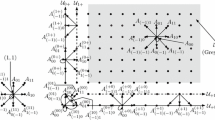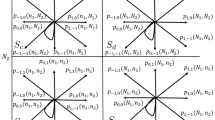Abstract
In this work, we focus on the stationary analysis of a specific class of continuous time Markov-modulated reflected random walks in the quarter plane with applications in the modelling of two-node Markov-modulated queueing networks with coupled queues. The transition rates of the two-dimensional process depend on the state of a finite state Markovian background process. Such a modulation is space homogeneous in the set of inner states of the two-dimensional lattice but may be different in the set of states at its boundaries. To obtain the stationary distribution, we apply the power series approximation method, and the theory of Riemann boundary value problems. We also obtain explicit expressions for the first moments of the stationary distribution under some symmetry assumptions. An application in the modelling of a priority retrial system with coupled orbit queues is also presented. Using a queueing network example, we numerically validated the theoretical findings.











Similar content being viewed by others
Notes
Note that \(\frac{\tau _{1}\tau _{2}}{\tau _{1}\tau _{2}+\gamma _{1}\tau _{2}+\gamma _{2}\tau _{1}}(\frac{\varLambda ^{(0)}_{1}}{\nu _{1}}+\frac{\varLambda ^{(0)}_{2}}{\nu _{2}})\) (resp. \(\frac{\gamma _{k}\tau _{(k+1)mod 2}}{\tau _{1}\tau _{2}+\gamma _{1}\tau _{2}+\gamma _{2}\tau _{1}}(\frac{\varLambda ^{(k)}_{1}}{\nu _{1}}+\frac{\varLambda ^{(k)}_{2}}{\nu _{2}})\)) refers to the amount of work that arrive at the system per time unit when the network is in the operating mode (resp. in the failed mode \(k=1,2\)), while a job can depart from the network only when it is in the operating mode, i.e., with probability \(\frac{\tau _{1}\tau _{2}}{\tau _{1}\tau _{2}+\gamma _{1}\tau _{2}+\gamma _{2}\tau _{1}}\).
References
Adan, I. J. B. F., Van Leeuwaarden, J. S. H., & Winands, E. M. M. (2006). On the application of Rouché’s theorem in queueing theory. Operations Research Letters, 34(3), 355–360.
Andradóttir, S., Ayhan, H., & Down, D. G. (2001). Server assignment policies for maximizing the steady-state throughput of finite queueing systems. Management Science, 47(10), 1421–1439.
Blom, J. G., Turck, K. D., & Mandjes, M. (2016). Functional central limit theorems for markov-modulated infinite-server systems. Mathematical Methods of Operations Research, 83(3), 351–372.
Blom, J. G., Turck, K. D., & Mandjes, M. (2017). Refined large deviations asymptotics for markov-modulated infinite-server systems. European Journal of Operational Research, 259(3), 1036–1044. https://doi.org/10.1016/j.ejor.2016.10.050.
Borst, S. (2003). User-level performance of channel-aware scheduling algorithms in wireless data networks. In: IEEE INFOCOM 2003. 22nd Annual Joint Conference of the IEEE Computer and Communications Societies (IEEE Cat. No.03CH37428), vol. 1, pp. 321–331 vol.1.
Cohen, J. (1988). Boundary value problems in queueing theory. Queueing Systems, 3, 97–128.
Cohen, J. (1992). Analysis of Random Walks. Amsterdam: IOS Press.
Cohen, J., & Boxma, O. (1983). Boundary value problems in queueing systems analysis. Amsterdam: North Holland Publishing Company.
Dimitriou, I. (2017). A queueing system for modeling cooperative wireless networks with coupled relay nodes and synchronized packet arrivals. Performance Evaluation, 114, 16–31.
Dimitriou, I. (2019). On the power series approximations of a structured batch arrival two-class retrial system with weighted fair orbit queues. Performance Evaluation, 132, 38–56.
Dimitriou, I. (2019). Stationary analysis of a tandem queue with coupled processors subject to global breakdowns. In T. Phung-Duc, S. Kasahara, & S. Wittevrongel (Eds.), Queueing theory and network applications (pp. 240–259). Cham: Springer International Publishing.
Dimitriou, I., & Pappas, N. (2018). Stable throughput and delay analysis of a random access network with queue-aware transmission. IEEE Transactions on Wireless Communications, 17(5), 3170–3184.
Dimitriou, I., & Pappas, N. (2019). Performance analysis of a cooperative wireless network with adaptive relays. Ad Hoc Networks, 87, 157–173.
Dimitriou, I., Phung-Duc, T. (2020). Analysis of cognitive radio networks with cooperative communication. In: Proceedings of the 13th EAI International Conference on Performance Evaluation Methodologies and Tools, VALUETOOLS 2020. Association for Computing Machinery, New York, NY, USA. https://doi.org/10.1145/3388831.3388859
Economou, A. (2005). Generalized product-form stationary distributions for markov chains in random environments with queueing applications. Advances in Applied Probability, 37(1), 185–211.
Fayolle, G., & Iasnogorodski, R. (1979). Two coupled processors: the reduction to a Riemann–Hilbert problem. Zeitschrift Fur Wahrscheinlichkeitstheorie Und Verwandte Gebiete, 47(3), 325–351.
Fayolle, G., Iasnogorodski, R., & Malyshev, V. (2017). Random walks in the quarter-plane: algebraic methods, boundary value problems. Berlin: Applications to Queueing Systems & Analytic Combinatorics. Springer.
Fayolle, G., Malyshev, V., & Menshikov, M. (1995). Constructive theory of Markov chains. Cambridge: Cambridge University Press.
Fiems, D., Mandjes, M., & Patch, B. (2018). Networks of infinite-server queues with multiplicative transitions. Performance Evaluation, 123, 35–49.
Gakhov, F. (1966). Boundary value problems. Oxford: Pergamon Press.
Gaver, D. P., Jacobs, P. A., & Latouche, G. (1984). Finite birth-and-death models in randomly changing environments. Advances in Applied Probability, 16(4), 715–731.
Gelenbe, E. (1991). Product-form queueing networks with negative and positive customers. Journal of applied probability, 28(3), 656–663.
Gelenbe, E. (1993). G-networks by triggered customer movement. Journal of Applied Probability, 30(3), 742–748.
Gelenbe, E. (1994). G-networks: a unifying model for neural and queueing networks. Annals of Operations Research, 48(5), 433–461.
Guillemin, F., & Pinchon, D. (2004). Analysis of generalized processor-sharing systems with two classes of customers and exponential services. Journal of Applied Probability, 41(3), 832–858.
Jansen, H. M., Mandjes, M., Turck, K. D., & Wittevrongel, S. (2019). Diffusion limits for networks of markov-modulated infinite-server queues. Performance Evaluation, 135, 102039.
Kabran, F.B., Sezer, A.D. (2019). Approximation of the exit probability of a stable markov modulated constrained random walk. arXiv:1909.06774 [math.PR] pp. 1–44
Kim, B., & Kim, J. (2015). A single server queue with markov modulated service rates and impatient customers. Performance Evaluation, 83–84, 1–15.
Kobayashi, M., & Miyazawa, M. (2014). Tail asymptotics of the stationary distribution of a two-dimensional reflecting random walk with unbounded upward jumps. Advances in Applied Probability, 46(2), 365–399.
Lefevre, C., & Milhaud, X. (1990). On the association of the lifelengths of components subjected to a stochastic environment. Advances in Applied Probability, 22(4), 961–964.
Lefèvre, C., & Michaletzky, G. (1990). Interparticle dependence in a linear death process subjected to a random environment. Journal of Applied Probability, 27(3), 491–498.
Miyazawa, M. (2011). Light tail asymptotics in multidimensional reflecting processes for queueing networks. TOP, 19(2), 233–299.
Miyazawa, M. (2017). Martingale approach for tail asymptotic problems in the generalized Jackson network. Probability and Mathematical Statistics, 37, 395–430.
Nehari, Z. (1952). Conformal mapping. New York: McGraw-Hill.
Neuts, M. F. (1981). Matrix-geometric solutions in stochastic models : an algorithmic approach / Marcel F. Neuts: Johns Hopkins University Press Baltimore.
Ozawa, T. (2013). Asymptotics for the stationary distribution in a discrete-time two-dimensional quasi-birth-and-death process. Queueing Systems, 74(2), 109–149.
Ozawa, T. (2019). Stability condition of a two-dimensional QBD process and its application to estimation of efficiency for two-queue models. Performance Evaluation, 130, 101–118.
Ozawa, T., & Kobayashi, M. (2018). Exact asymptotic formulae of the stationary distribution of a discrete-time two-dimensional qbd process. Queueing Systems: Theory and Applications, 90(3–4), 351–403.
Pacheco, A., Tang, L. C., & Prabhu, N. U. (2008). Markov-modulated processes and semiregenerative phenomena. Singapore: World Scientific. https://doi.org/10.1142/6757.
Prabhu, N. U., & Tang, L. C. (1994). Markov-modulated single-server queueing systems. Journal of Applied Probability, 31, 169–184.
Prabhu, N. U., & Zhu, Y. (1989). Markov-modulated queueing systems. Queueing Systems, 5(1), 215–245.
Queija, R.N. (1997). Steady-state analysis of a queue with varying service rate. Technical Report PNA-R9712, CWI
Resing, J., & Órmeci, L. (2003). A tandem queueing model with coupled processors. Operations Research Letters, 31(5), 383–389.
Titchmarsh, E. (1939). The theory of functions (2nd ed.). New York: Oxford University Press.
Vanlerberghe, J. (2018). Analysis and optimization of discrete-time generalized processor sharing queues. Ph.D. thesis, Ghent University.
van Leeuwaarden, J. S. H., & Resing, J. A. C. (2005). A tandem queue with coupled processors: computational issues. Queueing Systems, 51(1), 29–52.
Vanlerberghe, J., Walraevens, J., Maertens, T., Bruneel, H. (2014). Approximating the optimal weights for discrete-time generalized processor sharing. In: 2014 IFIP Networking Conference, pp. 1–9.
Vanlerberghe, J., Walraevens, J., Maertens, T., & Bruneel, H. (2015). On the influence of high priority customers on a generalized processor sharing queue. In M. Gribaudo, D. Manini, & A. Remke (Eds.), Analytical and stochastic modelling techniques and applications (pp. 203–216). Cham: Springer International Publishing.
Vanlerberghe, J., Walraevens, J., Maertens, T., & Bruneel, H. (2019). A procedure to approximate the mean queue content in a discrete-time generalized processor sharing queue with bernoulli arrivals. Performance Evaluation, 134, 102,001.
Vitale, C., Mancuso, V., Rizzo, G. (2015). Modelling D2D communications in cellular access networks via coupled processors. In: 2015 7th International Conference on Communication Systems and Networks (COMSNETS), pp. 1–8.
Walraevens, J., van Leeuwaarden, J. S. H., & Boxma, O. J. (2010). Power series approximations for two-class generalized processor sharing systems. Queueing Systems, 66(2), 107–130.
Zhu, Y. (1994). Markovian queueing networks in a random environment. Operations Research Letters, 15(1), 11–17.
Acknowledgements
The author would like to thank the Editor and the anonymous reviewers for the careful reading of the manuscript and the insightful remarks and input, which helped to improve the original exposition.
Author information
Authors and Affiliations
Corresponding author
Additional information
Publisher's Note
Springer Nature remains neutral with regard to jurisdictional claims in published maps and institutional affiliations.
Appendices
Appendix A
Theorem 5
For every \(|x|=1\), \(x\ne 1\), \(G(x,y)=0\) has a unique zero, say Y(x), in the disc \(|y|<1\).
Proof
In order to enhance the readability, we consider the case where \(\theta _{i,j}=0\), \(i,j=1,\ldots ,N\), so that T(x, y) is given in (16) (Sect. 3.2). Analogous arguments can be applied even in the general case, where \(\theta _{i,j}>0\), \(i,j=1,\ldots ,N\).
The proof is based on the application of Rouché’s theorem (Titchmarsh 1939; Adan et al. 2006). Note that \(G(x,y)=0\) is rewritten as \(G_{0}(x,y)=h(x,y):=y\sum _{j=1}^{N}\frac{\theta _{j,0}\theta _{0,j}A_{0,j}(x,y)A_{j,0}(x,y)}{D_{j}(x,y)}\), where
It is easy to see that \(G_{0}(x,y)=f(x,y)-g(x,y)\), with
We first show that \(G_{0}(x,y)=0\) has a unique root in \(|y|<1\), for \(|x|=1\), \(x\ne 1\). Then, for \(|x|=1\), \(x\ne 1\),
Then, for all y such that \(|y|=1\) have that
which implies by Rouché’s theorem, see, e.g. Titchmarsh (1939), that \(G_{0}(x,y)\) has as many zeros, counted according to their multiplicity, inside \(|y| = 1\) as f(x, y). Since f(x, y) has only one zero of multiplicity 1 at \(y = 0\), yields that for every x with \(|x| = 1\), \(x\ne 1\), \(G_{0}(x,y) = 0\) has one root inside \(|y| = 1\).
Now, note that
Moreover,
since \(|A_{0,j}(x,y)|=1\), \(|A_{j,0}(x,y)|=1\), \(|D_{j}(x,y)|\ge \theta _{j,0}\), for \(|x|=1\), \(|y|=1\), \(x\ne 1\). Thus,
Therefore, Rouché’s theorem implies that \(G_{0}(x,y)=y\sum _{j=1}^{N}\frac{\theta _{j,0}\theta _{0,j}}{D_{j}(x,y)}\), i.e., \(G(x,y)=0\) has the same number of zeros for every x with \(|x| = 1\), \(x\ne 1\), inside \(|y|=1\), as \(G_{0}(x,y)\), which we shown that has exactly one. Thus, denote this zero as \(y=Y(x)\), \(|x| = 1\), \(x\ne 1\), with \(|Y(x)|<1\). \(\square \)
Appendix B
Proof of Theorem 2:
To enhance the readability, we consider the case where \(\theta _{i,j}=0\), \(i,j=1,\ldots ,N\), and considered the QBD version of \(\{Z(t);t\ge 0\}\), i.e, \({\mathbb {H}}=\{-1,0,1\}\), \({\mathbb {H}}^{+}=\{0,1\}\). Analogous arguments can be applied even in the general case. The proof is based on the application of Rouché’s theorem (Titchmarsh 1939; Adan et al. 2006).
Note that \(U(gs,gs^{-1})=0\) is written as \(R(gs,gs^{-1})=g^{2}\sum _{j=1}^{N}\frac{\theta _{j,0}\theta _{0,j}}{D_{j}(gs,gs^{-1})}\). We first show that \(R(gs,gs^{-1})=0\) has a single root in \(|g|\le 1\), \(|s|=1\). Indeed, \(R(gs,gs^{-1}=0)\) is rewritten as
Note that the denominator of \(L(gs,gs^{-1})\) never vanishes for \(|g|\le 1\), \(|s|=1\) and in particular,
Therefore,
Thus, by applying Rouché’s theorem \(R(gs,gs^{-1})=0\) has a single zero in \(|g|<1\), \(|s|=1\). Note also that
On the other hand,
Therefore, since \(R(gs,gs^{-1})\) has a single zero in \(|g|<1\), \(|s=1|\), Rouché’s theorem states that \(R(gs,gs^{-1})=g^{2}\sum _{j=1}^{N}\frac{\theta _{j,0}\theta _{0,j}A_{0,j}(gs,gs^{-1})A_{j,0}(gs,gs^{-1})}{D_{j}(gs,gs^{-1})}\) has a single root in \(|g|<1\), \(|s=1|\). Equivalently, \(U(gs,gs^{-1})=0\) has a a single root in \(|g|<1\), \(|s=1|\). \(\square \)
Rights and permissions
About this article
Cite this article
Dimitriou, I. Stationary analysis of certain Markov-modulated reflected random walks in the quarter plane. Ann Oper Res 310, 355–387 (2022). https://doi.org/10.1007/s10479-020-03676-8
Published:
Issue Date:
DOI: https://doi.org/10.1007/s10479-020-03676-8




